Nursing Practice and Benner's Theory: A Formative Assessment
VerifiedAdded on 2021/10/13
|8
|2383
|39
Essay
AI Summary
This essay provides a formative assessment of nursing practice, focusing on Patricia Benner's theory of skill acquisition, which describes the progression from novice to expert in clinical nursing. The introduction highlights the evolution of nursing, emphasizing the importance of protecting the title of nurses and enhancing the practice related to nursing. The essay delves into Benner's theory, which applies the Dreyfus model of skill acquisition to nursing, outlining five stages: novice, advanced beginner, competent, proficient, and expert. It emphasizes the role of experience and simulation in skill development. The essay also discusses the application of this theory in practice, including the importance of clinical mentors and the need for nurses to develop through each stage. It references several journal articles to support the theory's implications in nursing, covering topics such as ethical development, complex acute care settings, and the use of simulation for training. The conclusion underscores the significance of the theory in enhancing patient care and improving the quality of life for individuals and communities.
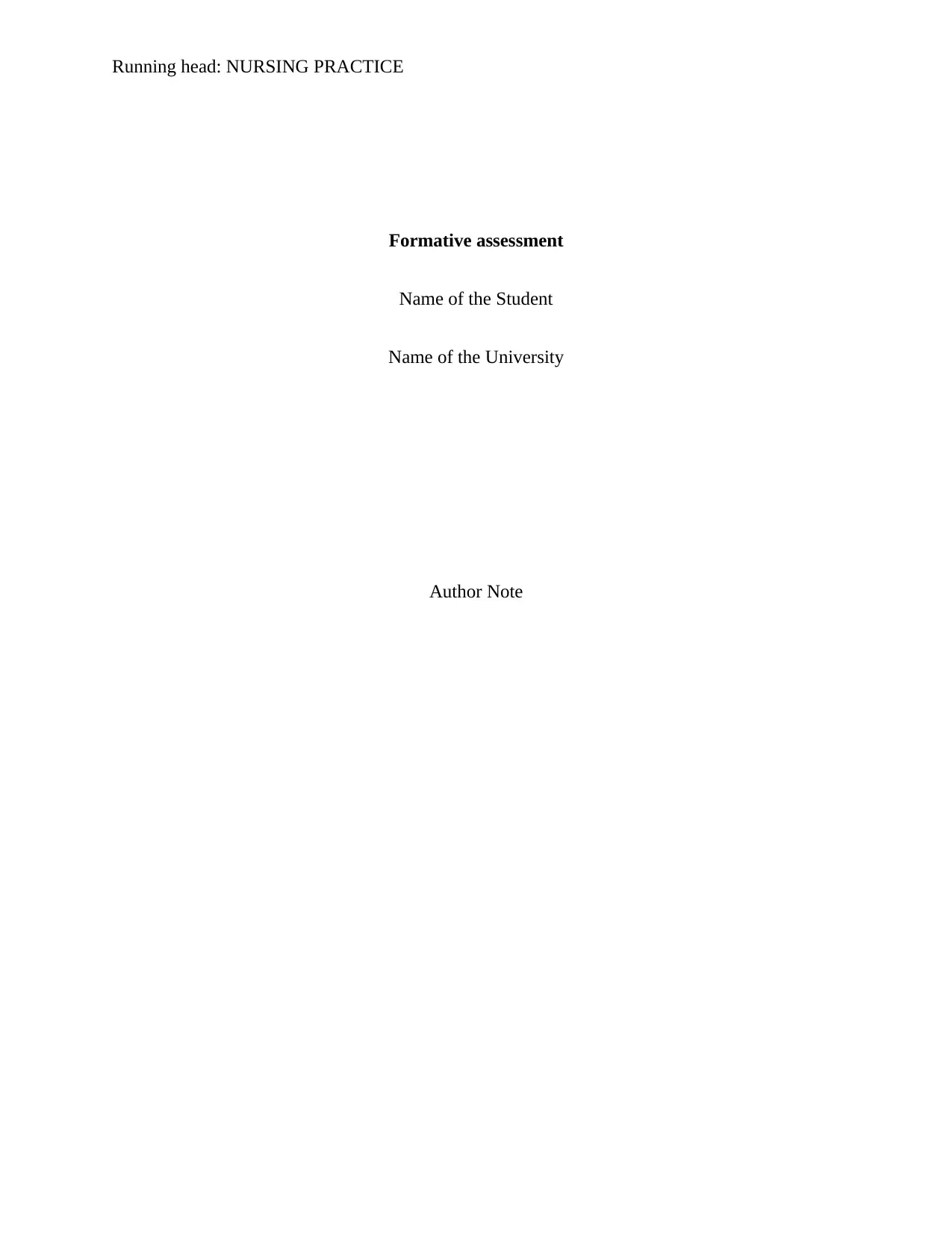
Running head: NURSING PRACTICE
Formative assessment
Name of the Student
Name of the University
Author Note
Formative assessment
Name of the Student
Name of the University
Author Note
Paraphrase This Document
Need a fresh take? Get an instant paraphrase of this document with our AI Paraphraser
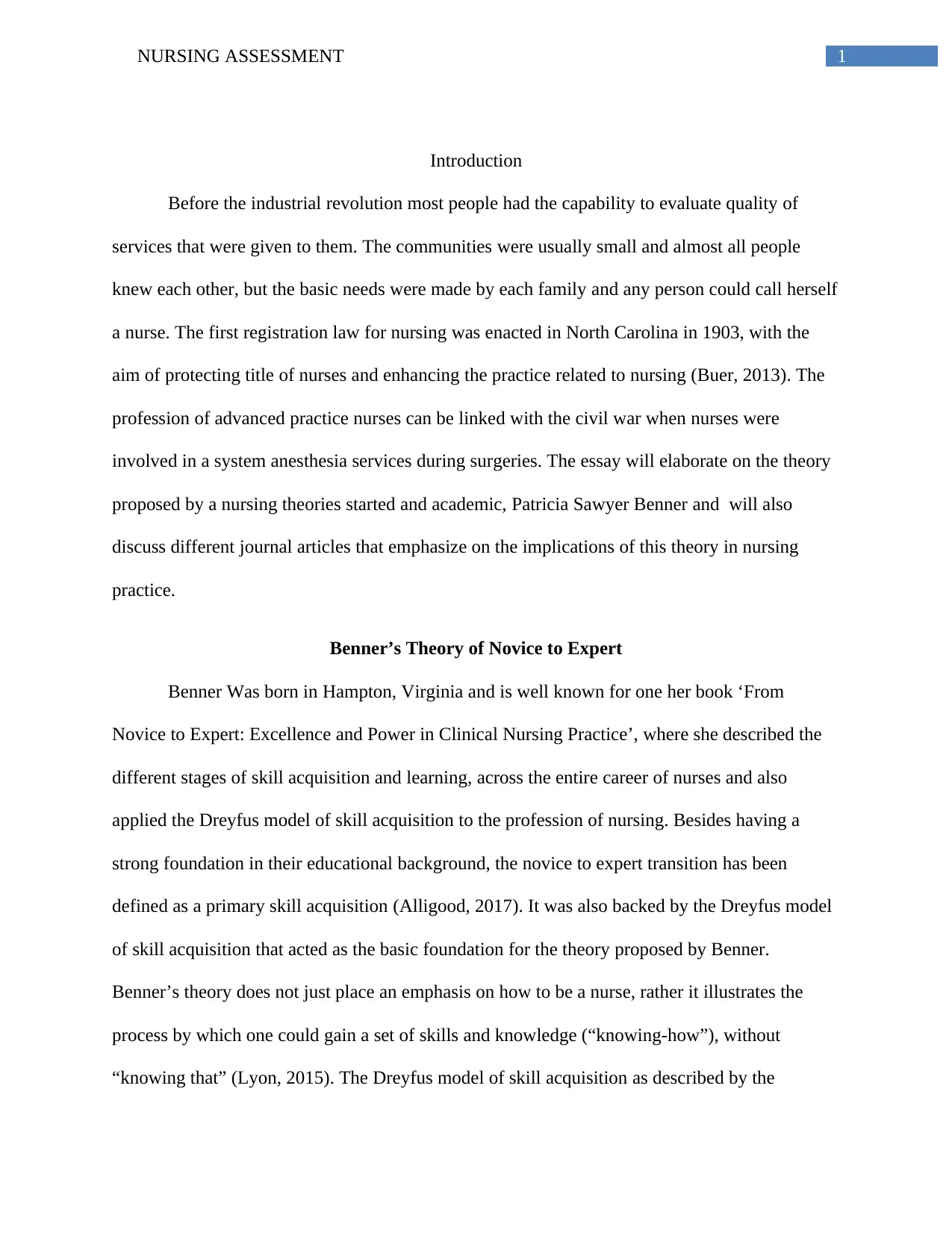
1NURSING ASSESSMENT
Introduction
Before the industrial revolution most people had the capability to evaluate quality of
services that were given to them. The communities were usually small and almost all people
knew each other, but the basic needs were made by each family and any person could call herself
a nurse. The first registration law for nursing was enacted in North Carolina in 1903, with the
aim of protecting title of nurses and enhancing the practice related to nursing (Buer, 2013). The
profession of advanced practice nurses can be linked with the civil war when nurses were
involved in a system anesthesia services during surgeries. The essay will elaborate on the theory
proposed by a nursing theories started and academic, Patricia Sawyer Benner and will also
discuss different journal articles that emphasize on the implications of this theory in nursing
practice.
Benner’s Theory of Novice to Expert
Benner Was born in Hampton, Virginia and is well known for one her book ‘From
Novice to Expert: Excellence and Power in Clinical Nursing Practice’, where she described the
different stages of skill acquisition and learning, across the entire career of nurses and also
applied the Dreyfus model of skill acquisition to the profession of nursing. Besides having a
strong foundation in their educational background, the novice to expert transition has been
defined as a primary skill acquisition (Alligood, 2017). It was also backed by the Dreyfus model
of skill acquisition that acted as the basic foundation for the theory proposed by Benner.
Benner’s theory does not just place an emphasis on how to be a nurse, rather it illustrates the
process by which one could gain a set of skills and knowledge (“knowing-how”), without
“knowing that” (Lyon, 2015). The Dreyfus model of skill acquisition as described by the
Introduction
Before the industrial revolution most people had the capability to evaluate quality of
services that were given to them. The communities were usually small and almost all people
knew each other, but the basic needs were made by each family and any person could call herself
a nurse. The first registration law for nursing was enacted in North Carolina in 1903, with the
aim of protecting title of nurses and enhancing the practice related to nursing (Buer, 2013). The
profession of advanced practice nurses can be linked with the civil war when nurses were
involved in a system anesthesia services during surgeries. The essay will elaborate on the theory
proposed by a nursing theories started and academic, Patricia Sawyer Benner and will also
discuss different journal articles that emphasize on the implications of this theory in nursing
practice.
Benner’s Theory of Novice to Expert
Benner Was born in Hampton, Virginia and is well known for one her book ‘From
Novice to Expert: Excellence and Power in Clinical Nursing Practice’, where she described the
different stages of skill acquisition and learning, across the entire career of nurses and also
applied the Dreyfus model of skill acquisition to the profession of nursing. Besides having a
strong foundation in their educational background, the novice to expert transition has been
defined as a primary skill acquisition (Alligood, 2017). It was also backed by the Dreyfus model
of skill acquisition that acted as the basic foundation for the theory proposed by Benner.
Benner’s theory does not just place an emphasis on how to be a nurse, rather it illustrates the
process by which one could gain a set of skills and knowledge (“knowing-how”), without
“knowing that” (Lyon, 2015). The Dreyfus model of skill acquisition as described by the
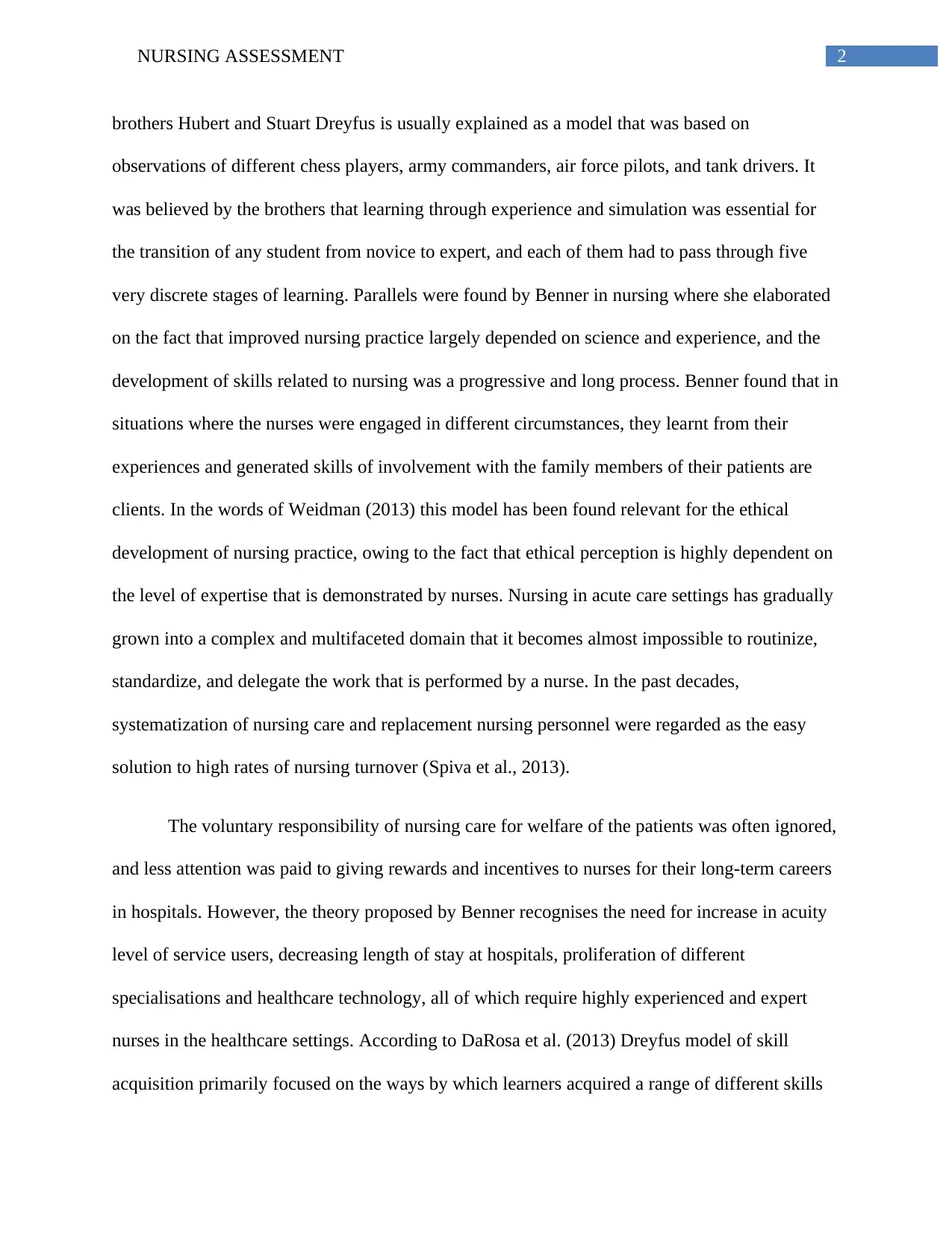
2NURSING ASSESSMENT
brothers Hubert and Stuart Dreyfus is usually explained as a model that was based on
observations of different chess players, army commanders, air force pilots, and tank drivers. It
was believed by the brothers that learning through experience and simulation was essential for
the transition of any student from novice to expert, and each of them had to pass through five
very discrete stages of learning. Parallels were found by Benner in nursing where she elaborated
on the fact that improved nursing practice largely depended on science and experience, and the
development of skills related to nursing was a progressive and long process. Benner found that in
situations where the nurses were engaged in different circumstances, they learnt from their
experiences and generated skills of involvement with the family members of their patients are
clients. In the words of Weidman (2013) this model has been found relevant for the ethical
development of nursing practice, owing to the fact that ethical perception is highly dependent on
the level of expertise that is demonstrated by nurses. Nursing in acute care settings has gradually
grown into a complex and multifaceted domain that it becomes almost impossible to routinize,
standardize, and delegate the work that is performed by a nurse. In the past decades,
systematization of nursing care and replacement nursing personnel were regarded as the easy
solution to high rates of nursing turnover (Spiva et al., 2013).
The voluntary responsibility of nursing care for welfare of the patients was often ignored,
and less attention was paid to giving rewards and incentives to nurses for their long-term careers
in hospitals. However, the theory proposed by Benner recognises the need for increase in acuity
level of service users, decreasing length of stay at hospitals, proliferation of different
specialisations and healthcare technology, all of which require highly experienced and expert
nurses in the healthcare settings. According to DaRosa et al. (2013) Dreyfus model of skill
acquisition primarily focused on the ways by which learners acquired a range of different skills
brothers Hubert and Stuart Dreyfus is usually explained as a model that was based on
observations of different chess players, army commanders, air force pilots, and tank drivers. It
was believed by the brothers that learning through experience and simulation was essential for
the transition of any student from novice to expert, and each of them had to pass through five
very discrete stages of learning. Parallels were found by Benner in nursing where she elaborated
on the fact that improved nursing practice largely depended on science and experience, and the
development of skills related to nursing was a progressive and long process. Benner found that in
situations where the nurses were engaged in different circumstances, they learnt from their
experiences and generated skills of involvement with the family members of their patients are
clients. In the words of Weidman (2013) this model has been found relevant for the ethical
development of nursing practice, owing to the fact that ethical perception is highly dependent on
the level of expertise that is demonstrated by nurses. Nursing in acute care settings has gradually
grown into a complex and multifaceted domain that it becomes almost impossible to routinize,
standardize, and delegate the work that is performed by a nurse. In the past decades,
systematization of nursing care and replacement nursing personnel were regarded as the easy
solution to high rates of nursing turnover (Spiva et al., 2013).
The voluntary responsibility of nursing care for welfare of the patients was often ignored,
and less attention was paid to giving rewards and incentives to nurses for their long-term careers
in hospitals. However, the theory proposed by Benner recognises the need for increase in acuity
level of service users, decreasing length of stay at hospitals, proliferation of different
specialisations and healthcare technology, all of which require highly experienced and expert
nurses in the healthcare settings. According to DaRosa et al. (2013) Dreyfus model of skill
acquisition primarily focused on the ways by which learners acquired a range of different skills
⊘ This is a preview!⊘
Do you want full access?
Subscribe today to unlock all pages.

Trusted by 1+ million students worldwide
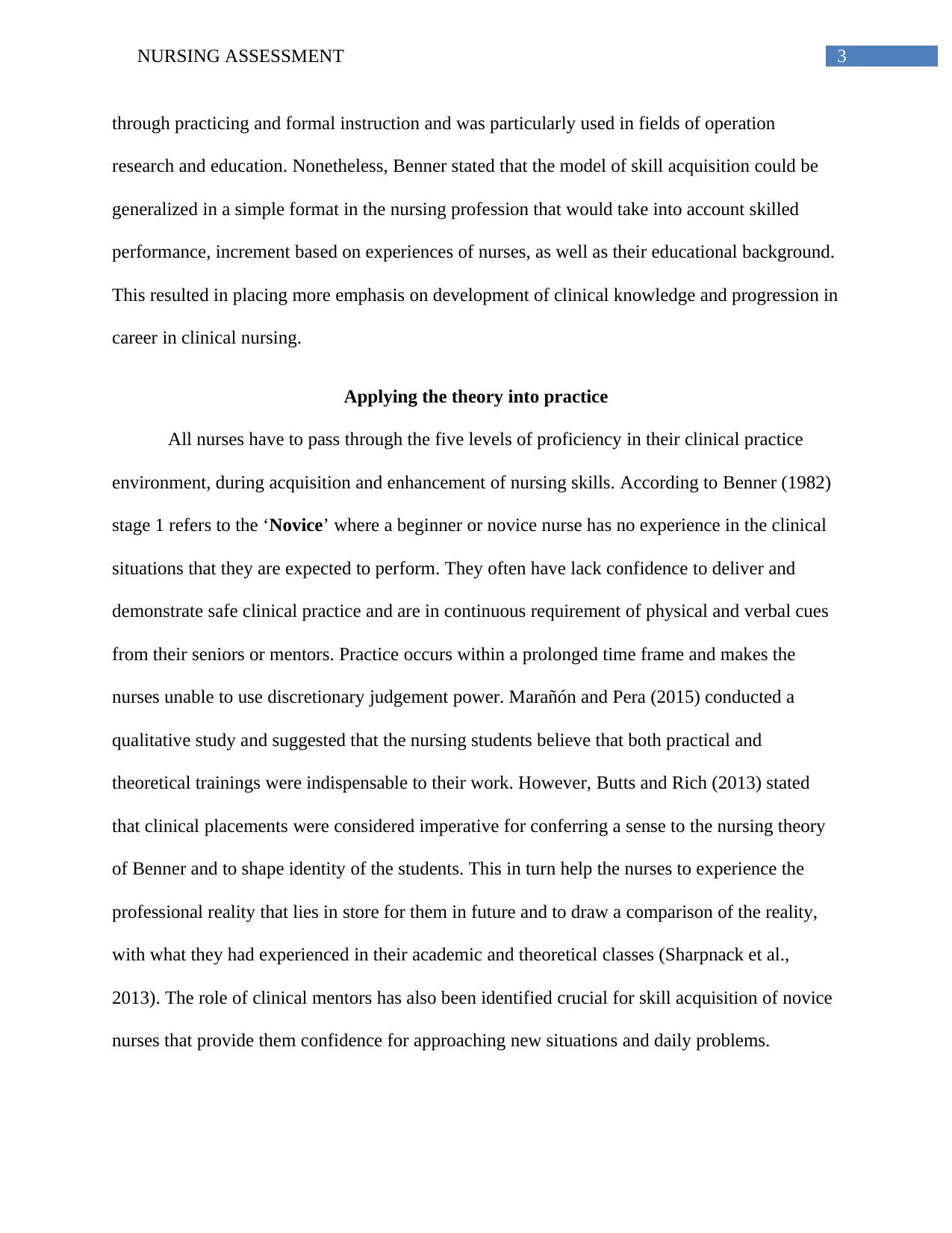
3NURSING ASSESSMENT
through practicing and formal instruction and was particularly used in fields of operation
research and education. Nonetheless, Benner stated that the model of skill acquisition could be
generalized in a simple format in the nursing profession that would take into account skilled
performance, increment based on experiences of nurses, as well as their educational background.
This resulted in placing more emphasis on development of clinical knowledge and progression in
career in clinical nursing.
Applying the theory into practice
All nurses have to pass through the five levels of proficiency in their clinical practice
environment, during acquisition and enhancement of nursing skills. According to Benner (1982)
stage 1 refers to the ‘Novice’ where a beginner or novice nurse has no experience in the clinical
situations that they are expected to perform. They often have lack confidence to deliver and
demonstrate safe clinical practice and are in continuous requirement of physical and verbal cues
from their seniors or mentors. Practice occurs within a prolonged time frame and makes the
nurses unable to use discretionary judgement power. Marañón and Pera (2015) conducted a
qualitative study and suggested that the nursing students believe that both practical and
theoretical trainings were indispensable to their work. However, Butts and Rich (2013) stated
that clinical placements were considered imperative for conferring a sense to the nursing theory
of Benner and to shape identity of the students. This in turn help the nurses to experience the
professional reality that lies in store for them in future and to draw a comparison of the reality,
with what they had experienced in their academic and theoretical classes (Sharpnack et al.,
2013). The role of clinical mentors has also been identified crucial for skill acquisition of novice
nurses that provide them confidence for approaching new situations and daily problems.
through practicing and formal instruction and was particularly used in fields of operation
research and education. Nonetheless, Benner stated that the model of skill acquisition could be
generalized in a simple format in the nursing profession that would take into account skilled
performance, increment based on experiences of nurses, as well as their educational background.
This resulted in placing more emphasis on development of clinical knowledge and progression in
career in clinical nursing.
Applying the theory into practice
All nurses have to pass through the five levels of proficiency in their clinical practice
environment, during acquisition and enhancement of nursing skills. According to Benner (1982)
stage 1 refers to the ‘Novice’ where a beginner or novice nurse has no experience in the clinical
situations that they are expected to perform. They often have lack confidence to deliver and
demonstrate safe clinical practice and are in continuous requirement of physical and verbal cues
from their seniors or mentors. Practice occurs within a prolonged time frame and makes the
nurses unable to use discretionary judgement power. Marañón and Pera (2015) conducted a
qualitative study and suggested that the nursing students believe that both practical and
theoretical trainings were indispensable to their work. However, Butts and Rich (2013) stated
that clinical placements were considered imperative for conferring a sense to the nursing theory
of Benner and to shape identity of the students. This in turn help the nurses to experience the
professional reality that lies in store for them in future and to draw a comparison of the reality,
with what they had experienced in their academic and theoretical classes (Sharpnack et al.,
2013). The role of clinical mentors has also been identified crucial for skill acquisition of novice
nurses that provide them confidence for approaching new situations and daily problems.
Paraphrase This Document
Need a fresh take? Get an instant paraphrase of this document with our AI Paraphraser
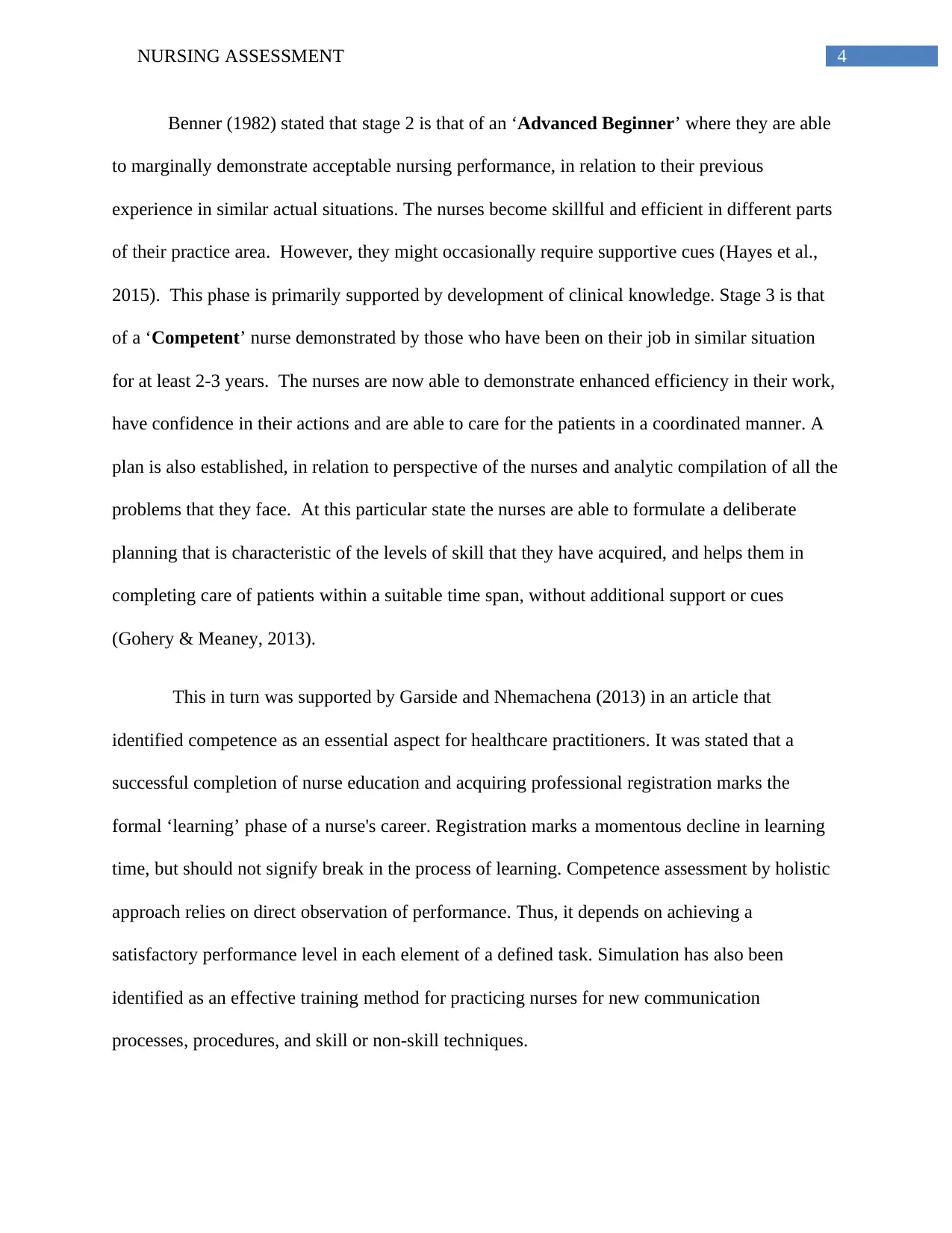
4NURSING ASSESSMENT
Benner (1982) stated that stage 2 is that of an ‘Advanced Beginner’ where they are able
to marginally demonstrate acceptable nursing performance, in relation to their previous
experience in similar actual situations. The nurses become skillful and efficient in different parts
of their practice area. However, they might occasionally require supportive cues (Hayes et al.,
2015). This phase is primarily supported by development of clinical knowledge. Stage 3 is that
of a ‘Competent’ nurse demonstrated by those who have been on their job in similar situation
for at least 2-3 years. The nurses are now able to demonstrate enhanced efficiency in their work,
have confidence in their actions and are able to care for the patients in a coordinated manner. A
plan is also established, in relation to perspective of the nurses and analytic compilation of all the
problems that they face. At this particular state the nurses are able to formulate a deliberate
planning that is characteristic of the levels of skill that they have acquired, and helps them in
completing care of patients within a suitable time span, without additional support or cues
(Gohery & Meaney, 2013).
This in turn was supported by Garside and Nhemachena (2013) in an article that
identified competence as an essential aspect for healthcare practitioners. It was stated that a
successful completion of nurse education and acquiring professional registration marks the
formal ‘learning’ phase of a nurse's career. Registration marks a momentous decline in learning
time, but should not signify break in the process of learning. Competence assessment by holistic
approach relies on direct observation of performance. Thus, it depends on achieving a
satisfactory performance level in each element of a defined task. Simulation has also been
identified as an effective training method for practicing nurses for new communication
processes, procedures, and skill or non-skill techniques.
Benner (1982) stated that stage 2 is that of an ‘Advanced Beginner’ where they are able
to marginally demonstrate acceptable nursing performance, in relation to their previous
experience in similar actual situations. The nurses become skillful and efficient in different parts
of their practice area. However, they might occasionally require supportive cues (Hayes et al.,
2015). This phase is primarily supported by development of clinical knowledge. Stage 3 is that
of a ‘Competent’ nurse demonstrated by those who have been on their job in similar situation
for at least 2-3 years. The nurses are now able to demonstrate enhanced efficiency in their work,
have confidence in their actions and are able to care for the patients in a coordinated manner. A
plan is also established, in relation to perspective of the nurses and analytic compilation of all the
problems that they face. At this particular state the nurses are able to formulate a deliberate
planning that is characteristic of the levels of skill that they have acquired, and helps them in
completing care of patients within a suitable time span, without additional support or cues
(Gohery & Meaney, 2013).
This in turn was supported by Garside and Nhemachena (2013) in an article that
identified competence as an essential aspect for healthcare practitioners. It was stated that a
successful completion of nurse education and acquiring professional registration marks the
formal ‘learning’ phase of a nurse's career. Registration marks a momentous decline in learning
time, but should not signify break in the process of learning. Competence assessment by holistic
approach relies on direct observation of performance. Thus, it depends on achieving a
satisfactory performance level in each element of a defined task. Simulation has also been
identified as an effective training method for practicing nurses for new communication
processes, procedures, and skill or non-skill techniques.
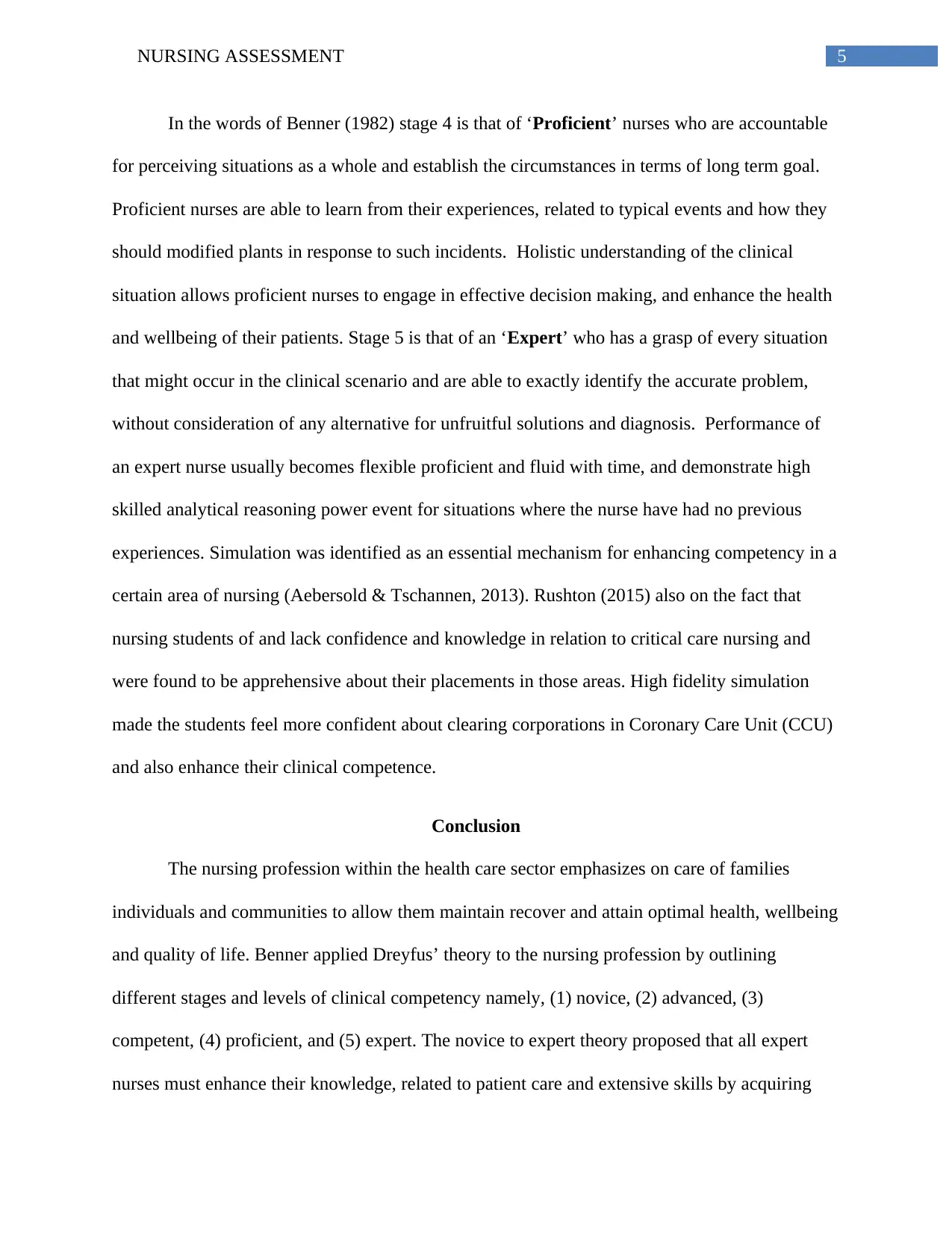
5NURSING ASSESSMENT
In the words of Benner (1982) stage 4 is that of ‘Proficient’ nurses who are accountable
for perceiving situations as a whole and establish the circumstances in terms of long term goal.
Proficient nurses are able to learn from their experiences, related to typical events and how they
should modified plants in response to such incidents. Holistic understanding of the clinical
situation allows proficient nurses to engage in effective decision making, and enhance the health
and wellbeing of their patients. Stage 5 is that of an ‘Expert’ who has a grasp of every situation
that might occur in the clinical scenario and are able to exactly identify the accurate problem,
without consideration of any alternative for unfruitful solutions and diagnosis. Performance of
an expert nurse usually becomes flexible proficient and fluid with time, and demonstrate high
skilled analytical reasoning power event for situations where the nurse have had no previous
experiences. Simulation was identified as an essential mechanism for enhancing competency in a
certain area of nursing (Aebersold & Tschannen, 2013). Rushton (2015) also on the fact that
nursing students of and lack confidence and knowledge in relation to critical care nursing and
were found to be apprehensive about their placements in those areas. High fidelity simulation
made the students feel more confident about clearing corporations in Coronary Care Unit (CCU)
and also enhance their clinical competence.
Conclusion
The nursing profession within the health care sector emphasizes on care of families
individuals and communities to allow them maintain recover and attain optimal health, wellbeing
and quality of life. Benner applied Dreyfus’ theory to the nursing profession by outlining
different stages and levels of clinical competency namely, (1) novice, (2) advanced, (3)
competent, (4) proficient, and (5) expert. The novice to expert theory proposed that all expert
nurses must enhance their knowledge, related to patient care and extensive skills by acquiring
In the words of Benner (1982) stage 4 is that of ‘Proficient’ nurses who are accountable
for perceiving situations as a whole and establish the circumstances in terms of long term goal.
Proficient nurses are able to learn from their experiences, related to typical events and how they
should modified plants in response to such incidents. Holistic understanding of the clinical
situation allows proficient nurses to engage in effective decision making, and enhance the health
and wellbeing of their patients. Stage 5 is that of an ‘Expert’ who has a grasp of every situation
that might occur in the clinical scenario and are able to exactly identify the accurate problem,
without consideration of any alternative for unfruitful solutions and diagnosis. Performance of
an expert nurse usually becomes flexible proficient and fluid with time, and demonstrate high
skilled analytical reasoning power event for situations where the nurse have had no previous
experiences. Simulation was identified as an essential mechanism for enhancing competency in a
certain area of nursing (Aebersold & Tschannen, 2013). Rushton (2015) also on the fact that
nursing students of and lack confidence and knowledge in relation to critical care nursing and
were found to be apprehensive about their placements in those areas. High fidelity simulation
made the students feel more confident about clearing corporations in Coronary Care Unit (CCU)
and also enhance their clinical competence.
Conclusion
The nursing profession within the health care sector emphasizes on care of families
individuals and communities to allow them maintain recover and attain optimal health, wellbeing
and quality of life. Benner applied Dreyfus’ theory to the nursing profession by outlining
different stages and levels of clinical competency namely, (1) novice, (2) advanced, (3)
competent, (4) proficient, and (5) expert. The novice to expert theory proposed that all expert
nurses must enhance their knowledge, related to patient care and extensive skills by acquiring
⊘ This is a preview!⊘
Do you want full access?
Subscribe today to unlock all pages.

Trusted by 1+ million students worldwide
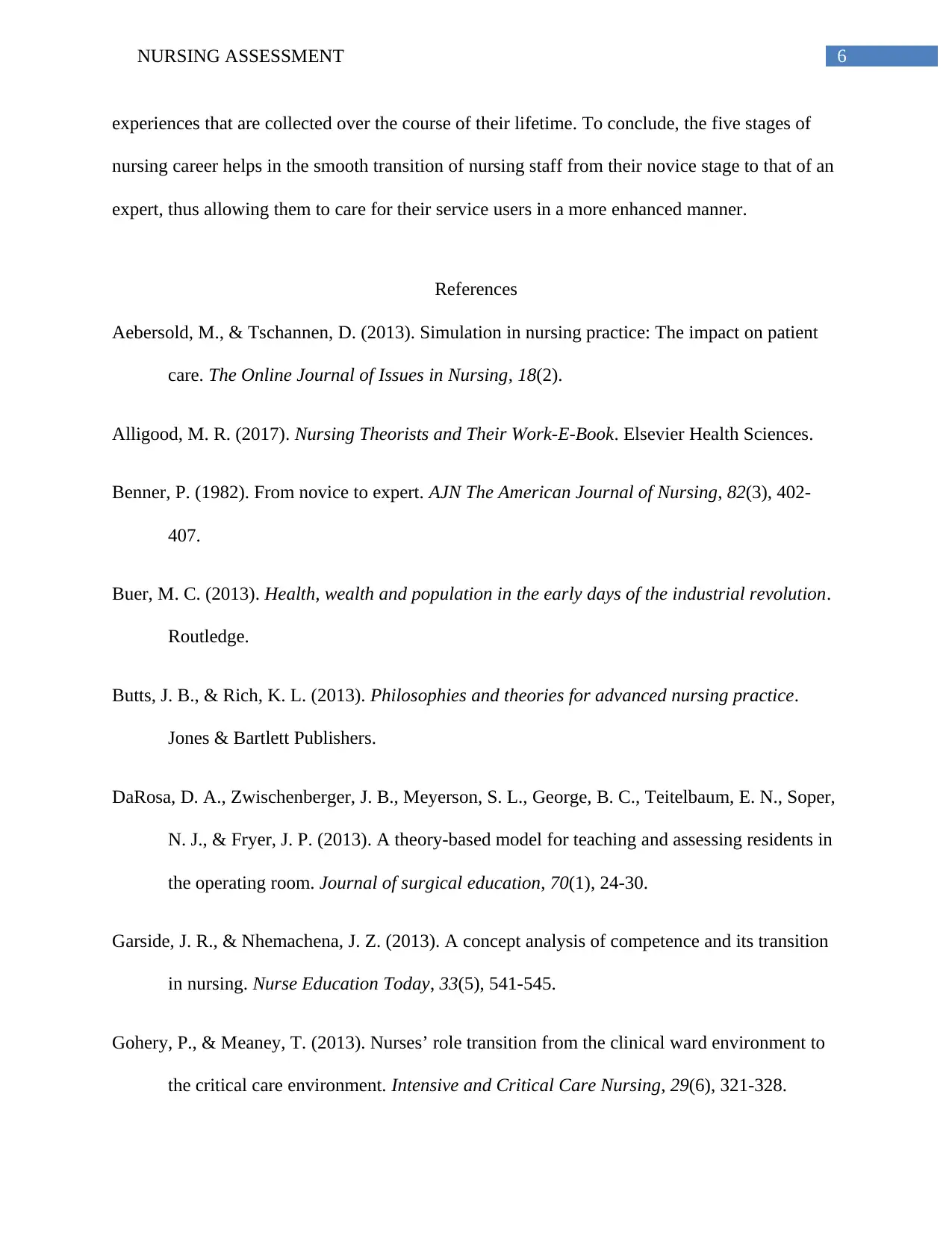
6NURSING ASSESSMENT
experiences that are collected over the course of their lifetime. To conclude, the five stages of
nursing career helps in the smooth transition of nursing staff from their novice stage to that of an
expert, thus allowing them to care for their service users in a more enhanced manner.
References
Aebersold, M., & Tschannen, D. (2013). Simulation in nursing practice: The impact on patient
care. The Online Journal of Issues in Nursing, 18(2).
Alligood, M. R. (2017). Nursing Theorists and Their Work-E-Book. Elsevier Health Sciences.
Benner, P. (1982). From novice to expert. AJN The American Journal of Nursing, 82(3), 402-
407.
Buer, M. C. (2013). Health, wealth and population in the early days of the industrial revolution.
Routledge.
Butts, J. B., & Rich, K. L. (2013). Philosophies and theories for advanced nursing practice.
Jones & Bartlett Publishers.
DaRosa, D. A., Zwischenberger, J. B., Meyerson, S. L., George, B. C., Teitelbaum, E. N., Soper,
N. J., & Fryer, J. P. (2013). A theory-based model for teaching and assessing residents in
the operating room. Journal of surgical education, 70(1), 24-30.
Garside, J. R., & Nhemachena, J. Z. (2013). A concept analysis of competence and its transition
in nursing. Nurse Education Today, 33(5), 541-545.
Gohery, P., & Meaney, T. (2013). Nurses’ role transition from the clinical ward environment to
the critical care environment. Intensive and Critical Care Nursing, 29(6), 321-328.
experiences that are collected over the course of their lifetime. To conclude, the five stages of
nursing career helps in the smooth transition of nursing staff from their novice stage to that of an
expert, thus allowing them to care for their service users in a more enhanced manner.
References
Aebersold, M., & Tschannen, D. (2013). Simulation in nursing practice: The impact on patient
care. The Online Journal of Issues in Nursing, 18(2).
Alligood, M. R. (2017). Nursing Theorists and Their Work-E-Book. Elsevier Health Sciences.
Benner, P. (1982). From novice to expert. AJN The American Journal of Nursing, 82(3), 402-
407.
Buer, M. C. (2013). Health, wealth and population in the early days of the industrial revolution.
Routledge.
Butts, J. B., & Rich, K. L. (2013). Philosophies and theories for advanced nursing practice.
Jones & Bartlett Publishers.
DaRosa, D. A., Zwischenberger, J. B., Meyerson, S. L., George, B. C., Teitelbaum, E. N., Soper,
N. J., & Fryer, J. P. (2013). A theory-based model for teaching and assessing residents in
the operating room. Journal of surgical education, 70(1), 24-30.
Garside, J. R., & Nhemachena, J. Z. (2013). A concept analysis of competence and its transition
in nursing. Nurse Education Today, 33(5), 541-545.
Gohery, P., & Meaney, T. (2013). Nurses’ role transition from the clinical ward environment to
the critical care environment. Intensive and Critical Care Nursing, 29(6), 321-328.
Paraphrase This Document
Need a fresh take? Get an instant paraphrase of this document with our AI Paraphraser
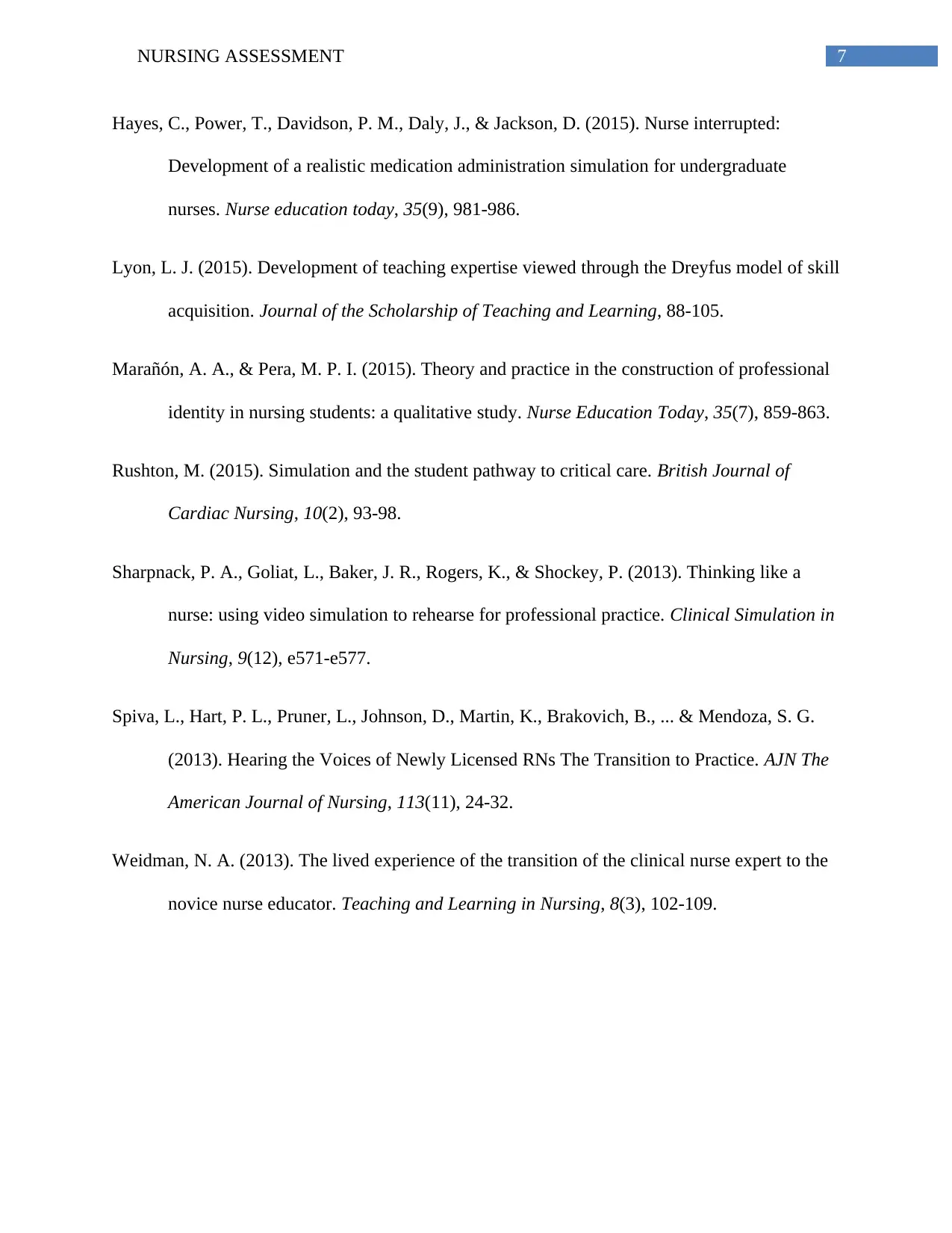
7NURSING ASSESSMENT
Hayes, C., Power, T., Davidson, P. M., Daly, J., & Jackson, D. (2015). Nurse interrupted:
Development of a realistic medication administration simulation for undergraduate
nurses. Nurse education today, 35(9), 981-986.
Lyon, L. J. (2015). Development of teaching expertise viewed through the Dreyfus model of skill
acquisition. Journal of the Scholarship of Teaching and Learning, 88-105.
Marañón, A. A., & Pera, M. P. I. (2015). Theory and practice in the construction of professional
identity in nursing students: a qualitative study. Nurse Education Today, 35(7), 859-863.
Rushton, M. (2015). Simulation and the student pathway to critical care. British Journal of
Cardiac Nursing, 10(2), 93-98.
Sharpnack, P. A., Goliat, L., Baker, J. R., Rogers, K., & Shockey, P. (2013). Thinking like a
nurse: using video simulation to rehearse for professional practice. Clinical Simulation in
Nursing, 9(12), e571-e577.
Spiva, L., Hart, P. L., Pruner, L., Johnson, D., Martin, K., Brakovich, B., ... & Mendoza, S. G.
(2013). Hearing the Voices of Newly Licensed RNs The Transition to Practice. AJN The
American Journal of Nursing, 113(11), 24-32.
Weidman, N. A. (2013). The lived experience of the transition of the clinical nurse expert to the
novice nurse educator. Teaching and Learning in Nursing, 8(3), 102-109.
Hayes, C., Power, T., Davidson, P. M., Daly, J., & Jackson, D. (2015). Nurse interrupted:
Development of a realistic medication administration simulation for undergraduate
nurses. Nurse education today, 35(9), 981-986.
Lyon, L. J. (2015). Development of teaching expertise viewed through the Dreyfus model of skill
acquisition. Journal of the Scholarship of Teaching and Learning, 88-105.
Marañón, A. A., & Pera, M. P. I. (2015). Theory and practice in the construction of professional
identity in nursing students: a qualitative study. Nurse Education Today, 35(7), 859-863.
Rushton, M. (2015). Simulation and the student pathway to critical care. British Journal of
Cardiac Nursing, 10(2), 93-98.
Sharpnack, P. A., Goliat, L., Baker, J. R., Rogers, K., & Shockey, P. (2013). Thinking like a
nurse: using video simulation to rehearse for professional practice. Clinical Simulation in
Nursing, 9(12), e571-e577.
Spiva, L., Hart, P. L., Pruner, L., Johnson, D., Martin, K., Brakovich, B., ... & Mendoza, S. G.
(2013). Hearing the Voices of Newly Licensed RNs The Transition to Practice. AJN The
American Journal of Nursing, 113(11), 24-32.
Weidman, N. A. (2013). The lived experience of the transition of the clinical nurse expert to the
novice nurse educator. Teaching and Learning in Nursing, 8(3), 102-109.
1 out of 8
Related Documents
Your All-in-One AI-Powered Toolkit for Academic Success.
+13062052269
info@desklib.com
Available 24*7 on WhatsApp / Email
![[object Object]](/_next/static/media/star-bottom.7253800d.svg)
Unlock your academic potential
Copyright © 2020–2025 A2Z Services. All Rights Reserved. Developed and managed by ZUCOL.





